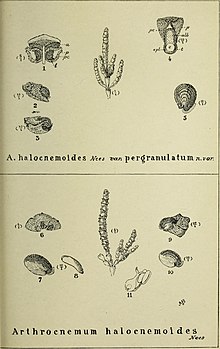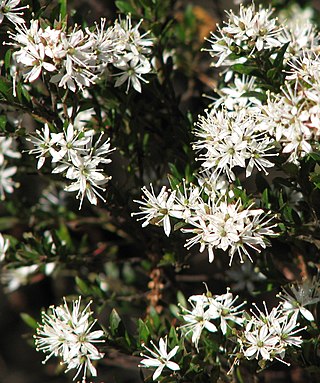
Leionema is a genus of more than 20 species of mostly small shrubs in the family Rutaceae, most of which are endemic to eastern Australia. Plants within this genus have scented foliage and clustered, star-shaped flowers which range in colour from cream to bright yellow. Prior to 1998, all species within this genus were included in the genus Phebalium.
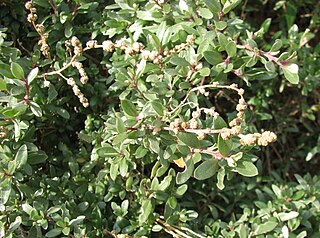
Atriplex paludosa, commonly known as marsh saltbush, is a species of saltbush endemic to Australia.
Atriplex vesicaria subsp. variabilis is subspecies of bladder saltbush endemic to Australia.
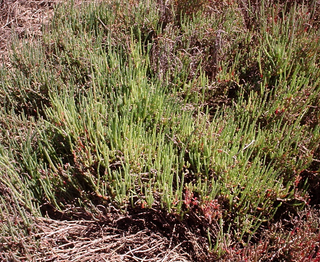
Tecticornia is a genus of succulent, salt tolerant plants largely endemic to Australia. Taxa in the genus are commonly referred to as samphires. In 2007, the genus Halosarcia, along with three other Australian genera was incorporated into the genus.
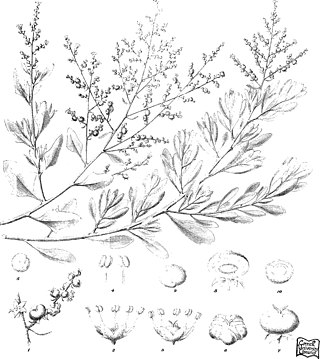
Chenopodium baccatum, commonly known as berry saltbush, is a species of shrub endemic to Western Australia.
Chenopodium benthamii is a species of shrub endemic to midwest Western Australia.

Tecticornia arbuscula, the shrubby glasswort or scrubby samphire, is a species of plant in the family Amaranthaceae, native to Australia. It is a shrub that grows to 2 metres in height, with a spreading habit. It has succulent swollen branchlets with small leaf lobes.

Tecticornia pergranulata is a succulent halophytic plant species in the family Chenopodiaceae, native to Australia. This plant is commonly tested in labs involving its C3 photosynthesis and its unique resistance to salinity and adversity.

Adenanthos pungens, the spiky adenanthos, is a species of shrub in the family Proteaceae. It is endemic to the south-west of Western Australia.
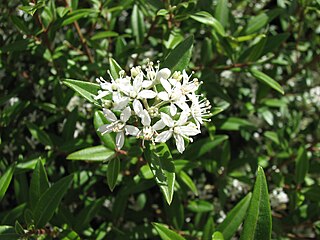
Nematolepis squamea , commonly known as Satinwood, is an upright shrub or small tree species which is endemic to Australia.

Microcybe multiflora is a small shrub in the family Rutaceae. The species is endemic to Australia. It usually grows to between 0.2 and 1 metre high and produces cream to yellow flowers.

Cyanothamnus baeckeaceus is a plant in the citrus family, Rutaceae and is endemic to eastern Australia. It is a slender or straggling shrub with simple or trifoliate leaves and pink and white four-petalled flowers. It is endemic to the south-west of Western Australia.

Cyanothamnus coerulescens, commonly known as blue boronia, is a plant in the citrus family, Rutaceae and is endemic to southern Australia. It is a small, spindly shrub with glandular stems, small, more or less cylindrical leaves and blue to pinkish mauve, four-petalled flowers. There are two subspecies endemic to Western Australia and a third that also occurs in three eastern states.
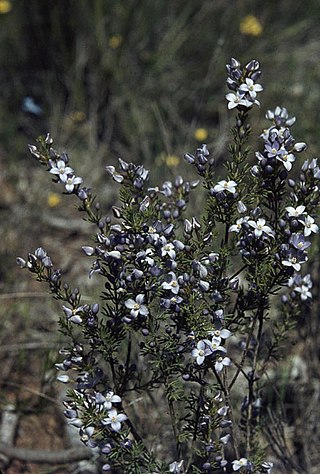
Cyanothamnus ramosus is a species of plant in the citrus family Rutaceae and is endemic to the southwest of Western Australia. It is an erect, mostly glabrous shrub with pinnate leaves with up to seven leaflets, and white, four-petalled flowers with blue or pale green backs.
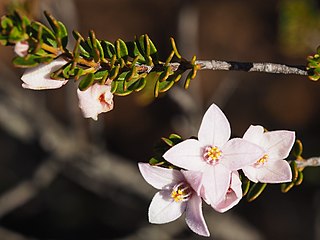
Boronia scabra, commonly known as rough boronia, is a plant in the citrus family, Rutaceae and is endemic to the south-west of Western Australia. It is an open shrub with simple, often clustered, oblong to elliptic leaves, and pink, mostly four-petalled flowers.
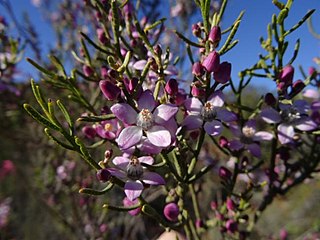
Philotheca brucei is a species of flowering plant in the family Rutaceae and is endemic to Western Australia. It is a shrub with cylindrical leaves grooved along the top and in spring, white to pink or mauve flowers with five egg-shaped petals.

Rhadinothamnus rudis is a small shrub with needle-shaped, angular branchlets and single white flowers at the end of branches. This species and the three subspecies are endemic to Western Australia.

Philotheca deserti is a species of flowering plant in the family Rutaceae and is endemic to inland Western Australia. It is an erect shrub with narrow spindle-shaped, glandular-warty leaves and white flowers arranged singly in leaf axils.

Philotheca gardneri is a species of flowering plant in the family Rutaceae and is endemic to the south-west of Western Australia. It is a shrub with crowded, narrow club-shaped or more or less spherical leaves and white flowers with a prominent pink midrib, usually borne singly on the ends of branchlets.

Philotheca nodiflora is a species of flowering plant in the family Rutaceae and is endemic to Western Australia. It is a weak shrub with more or less cylindrical leaves and blue to pink flowers arranged in compact heads.

